One of the most iconic images of post-Renaissance London has been redrawn, revealing just how much the capital has changed in four centuries.
The 1616 Visscher engraving details the city from Whitehall to St Katharine’s Dock and has been described as one of the most 'recognisable and historic' images of London.
It has now been reimagined by Robin Reynolds, who has completed a six-feet-long version of the panorama in pen and ink.
The piece, which is now on show at Guildhall Art Gallery, highlights how the city has changed in 400 years, including the additions of Tower Bridge and The Gherkin.
It also ties in with 400 years since Shakespeare's death and consequently contains 41 hidden references to the writer's plays and sonnets.
What a difference four centuries make: How London's skyline has completely changed since 1616
Visscher engraving from 400 years ago details the city from Whitehall to St Katharine's Dock in great detail
New six-feet-long version of the 1616 panorama was completed by Robin Reynolds, who used pen and ink
Modern piece also includes hidden reference to Shakespeare's plays to commemorate anniversary of his death
By Lydia Willgress for MailOnline
5 March 2016
Daily Mail
One of the most iconic images of post-Renaissance London has been redrawn, revealing just how much the capital has changed in four centuries.
The 1616 Visscher engraving details the city from Whitehall to St Katharine’s Dock and has been described as one of the most 'recognisable and historic' images of London.
It has now been reimagined by Robin Reynolds, who has completed a six-feet-long version of the panorama in pen and ink.
The piece, which is now on show at Guildhall Art Gallery, highlights how the city has changed in 400 years, including the additions of Tower Bridge and The Gherkin.
It also ties in with 400 years since Shakespeare's death and consequently contains 41 hidden references to the writer's plays and sonnets.
Mr Reynolds, who used to be a journalist and had only ever pursued art as a hobby previously, said he was initially prompted to get involved in the project because he felt his style was similar to the engraver's.
He told MailOnline: 'A few years ago I had this idea that I could try and do a modern version, but I didn't do anything with it as I didn't have time.
'I retired in 2007 and had a bit of time and then I really began to look seriously at it. I hadn't clocked the Shakespeare connection before but when I did it it became apparent it was the perfect time.'
Mr Reynolds revealed he initially started on the drawing, which was completed on acid-free paper, nearly two years ago. He penned in the cathedral and foreground before moving on to Cannon Street station and the background.
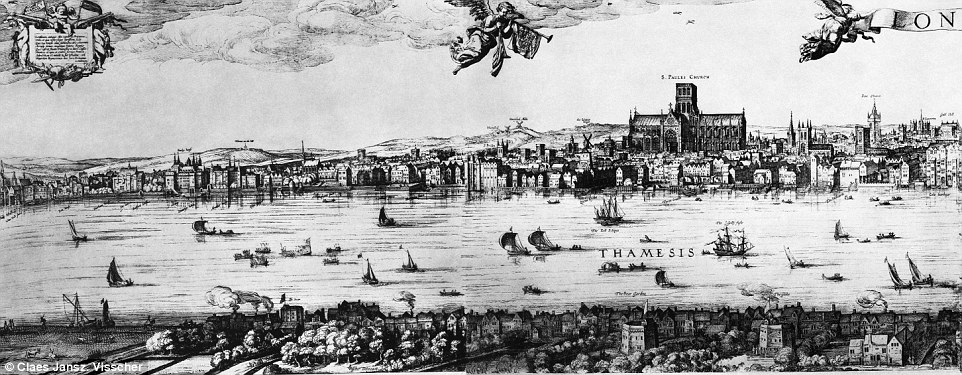
The 1616 Visscher engraving (above, the old St Paul's Cathedral dominating the skyline) details the city from Whitehall to St Katharine’s Dock and has been described as one of the most 'recognisable and historic' images of London
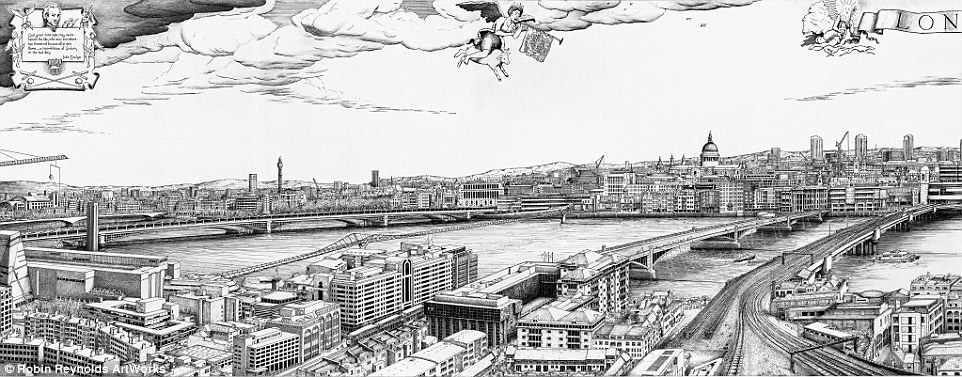
The engraving has now been reimagined by Robin Reynolds, who has completed a two-metre-long version of the panorama in pen and ink
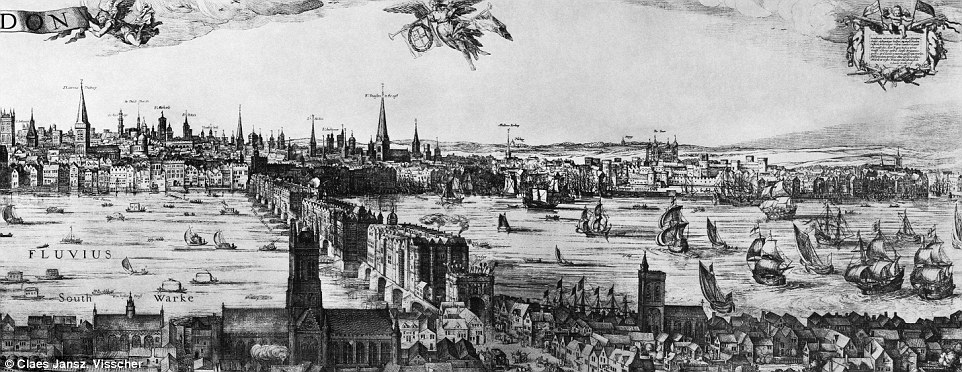
The 1616 version, which was completed on four plates, includes dozens of ships with huge sails on the Thames and features few high-rise buildings
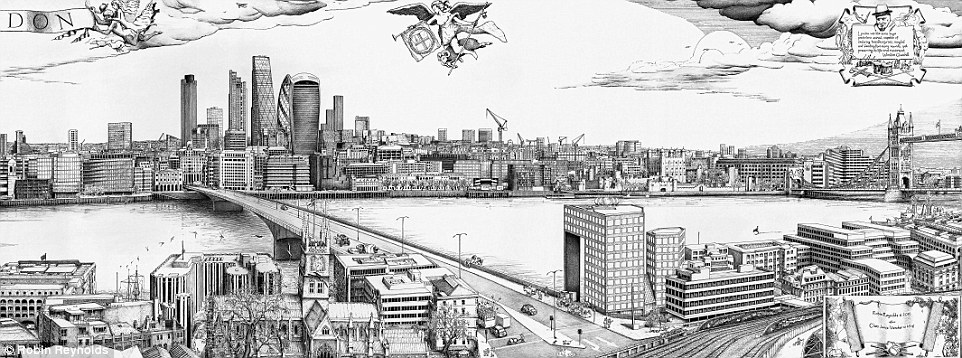
The new piece, which is now on show at Guildhall Art Gallery, highlights how the city has changed in 400 years, including the additions of Tower Bridge and The Gherkin
The hidden Shakespeare references were chosen after hours trawling through his plays, Mr Reynolds added.
'It's possible to pick some of them out just from having a basic knowledge of the plays - everyone knows Romeo and Juliet,' he said.
'The others you need the clue or the line from the play. You have to think of the visual possibilities.'
The drawing also contains two quotations about the Blitz and the Great Fire in a bid to show the significant events that have shaped the city.
Mr Reynolds added: 'Art has really always been a hobby for me. I'm not a specialist or an art historian - but I do have a big interest in history and art and my own hobby and I'm very, very pleased at the response so far.'
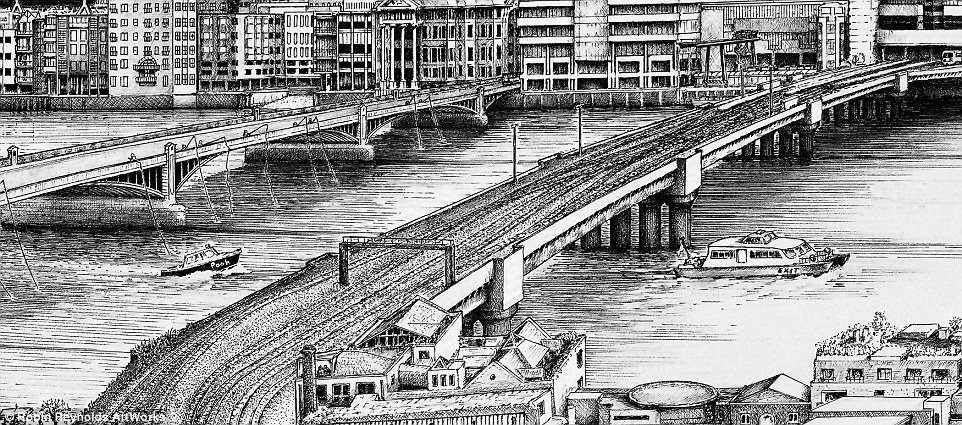
Mr Reynolds revealed he initially started on the drawing (shown above in closer detail), which was completed on acid-free paper, nearly two years ago
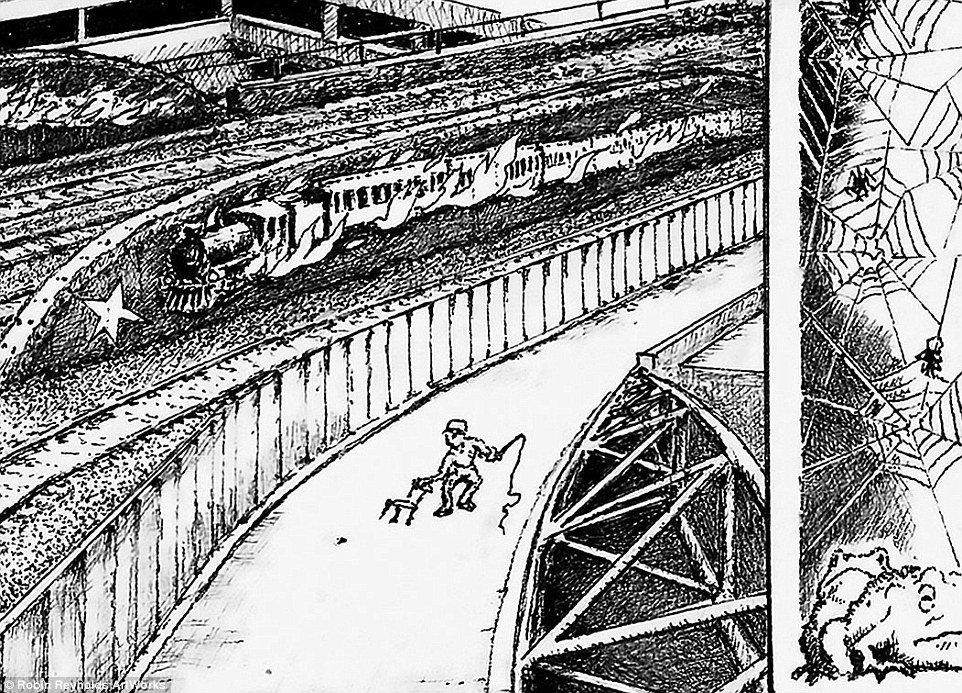
The new piece also ties in with 400 years since Shakespeare's death and consequently contains 41 hidden references to the writer's plays and sonnets. Can you guess the one above?
Sonia Solicari, curator of Guildhall Art Gallery, expressed delight that Mr Reynolds had chosen to showpiece his work at the gallery.
She added: 'Visitors to the art gallery will certainly enjoy comparing the 400-year-old engraving to details in the new work, and trying to spot Robin’s references to the plays, poetry and sonnets.'
Mr Reynolds' piece is currently on display at the Guildhall Art Gallery. To see the piece online and get access to the clues, click here.
The 1616 Visscher engraving details the city from Whitehall to St Katharine’s Dock and has been described as one of the most 'recognisable and historic' images of London.
It has now been reimagined by Robin Reynolds, who has completed a six-feet-long version of the panorama in pen and ink.
The piece, which is now on show at Guildhall Art Gallery, highlights how the city has changed in 400 years, including the additions of Tower Bridge and The Gherkin.
It also ties in with 400 years since Shakespeare's death and consequently contains 41 hidden references to the writer's plays and sonnets.
What a difference four centuries make: How London's skyline has completely changed since 1616
Visscher engraving from 400 years ago details the city from Whitehall to St Katharine's Dock in great detail
New six-feet-long version of the 1616 panorama was completed by Robin Reynolds, who used pen and ink
Modern piece also includes hidden reference to Shakespeare's plays to commemorate anniversary of his death
By Lydia Willgress for MailOnline
5 March 2016
Daily Mail
One of the most iconic images of post-Renaissance London has been redrawn, revealing just how much the capital has changed in four centuries.
The 1616 Visscher engraving details the city from Whitehall to St Katharine’s Dock and has been described as one of the most 'recognisable and historic' images of London.
It has now been reimagined by Robin Reynolds, who has completed a six-feet-long version of the panorama in pen and ink.
The piece, which is now on show at Guildhall Art Gallery, highlights how the city has changed in 400 years, including the additions of Tower Bridge and The Gherkin.
It also ties in with 400 years since Shakespeare's death and consequently contains 41 hidden references to the writer's plays and sonnets.
Mr Reynolds, who used to be a journalist and had only ever pursued art as a hobby previously, said he was initially prompted to get involved in the project because he felt his style was similar to the engraver's.
He told MailOnline: 'A few years ago I had this idea that I could try and do a modern version, but I didn't do anything with it as I didn't have time.
'I retired in 2007 and had a bit of time and then I really began to look seriously at it. I hadn't clocked the Shakespeare connection before but when I did it it became apparent it was the perfect time.'
Mr Reynolds revealed he initially started on the drawing, which was completed on acid-free paper, nearly two years ago. He penned in the cathedral and foreground before moving on to Cannon Street station and the background.
The 1616 Visscher engraving (above, the old St Paul's Cathedral dominating the skyline) details the city from Whitehall to St Katharine’s Dock and has been described as one of the most 'recognisable and historic' images of London

The engraving has now been reimagined by Robin Reynolds, who has completed a two-metre-long version of the panorama in pen and ink

The 1616 version, which was completed on four plates, includes dozens of ships with huge sails on the Thames and features few high-rise buildings

The new piece, which is now on show at Guildhall Art Gallery, highlights how the city has changed in 400 years, including the additions of Tower Bridge and The Gherkin
The hidden Shakespeare references were chosen after hours trawling through his plays, Mr Reynolds added.
'It's possible to pick some of them out just from having a basic knowledge of the plays - everyone knows Romeo and Juliet,' he said.
'The others you need the clue or the line from the play. You have to think of the visual possibilities.'
The drawing also contains two quotations about the Blitz and the Great Fire in a bid to show the significant events that have shaped the city.
Mr Reynolds added: 'Art has really always been a hobby for me. I'm not a specialist or an art historian - but I do have a big interest in history and art and my own hobby and I'm very, very pleased at the response so far.'

Mr Reynolds revealed he initially started on the drawing (shown above in closer detail), which was completed on acid-free paper, nearly two years ago

The new piece also ties in with 400 years since Shakespeare's death and consequently contains 41 hidden references to the writer's plays and sonnets. Can you guess the one above?
Sonia Solicari, curator of Guildhall Art Gallery, expressed delight that Mr Reynolds had chosen to showpiece his work at the gallery.
She added: 'Visitors to the art gallery will certainly enjoy comparing the 400-year-old engraving to details in the new work, and trying to spot Robin’s references to the plays, poetry and sonnets.'
Mr Reynolds' piece is currently on display at the Guildhall Art Gallery. To see the piece online and get access to the clues, click here.